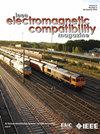Simulation and Measurement Based Study of the Asymptotic Low-Frequency Electric and Magnetic Shielding Effectiveness for Board Level Applications
IF 2.5
3区 计算机科学
Q3 ENGINEERING, ELECTRICAL & ELECTRONIC
IEEE Transactions on Electromagnetic Compatibility
Pub Date : 2025-04-28
DOI:10.1109/TEMC.2025.3560739
引用次数: 0
Abstract
In this article, the application of different types of sources to characterize board level electric and magnetic shielding effectiveness (SE) within the frequency range of 10 MHz–10 GHz is investigated. Our primary focus is on characterizing practical SE values for board level shields (BLSs) using the SAE ARP 6248 stripline method, which was originally designed for on-board gaskets. Various on-board sources and the corresponding SE of a BLS are elucidated to gauge their performance in the near-field region, particularly considering the close proximity between the shields and on-board sources. Our investigation integrates both 3-D modeling using the finite-difference-time-domain solver and measurements. In addition, the shielding performance of a BLS based on total radiated power (TRP) is studied in 3-D modeling to provide a comparison with the stripline method. It is shown that there is a correlation between wave impedance and SE of BLSs, which helps discern the nature of the on-board sources, i.e., asymptotic behavior of electric and magnetic sources. Notably, the numerical simulation study demonstrates a good level of agreement between the stripline method and the method based on TRP. Finally, validation through practical laboratory experiments using the stripline method confirms a significant alignment between the measured and simulated SE values.基于仿真和测量的电路板级渐近低频电磁屏蔽效能研究
本文研究了在10mhz - 10ghz频率范围内,用不同类型的源来表征板级电磁屏蔽效能(SE)。我们的主要重点是使用SAE ARP 6248带状线方法表征电路板电平屏蔽(bls)的实际SE值,该方法最初是为板载垫片设计的。阐明了各种机载光源和相应的电磁散射系数,以衡量其在近场区域的性能,特别是考虑到屏蔽和机载光源之间的距离很近。我们的研究整合了使用有限差分时域求解器的三维建模和测量。此外,在三维建模中研究了基于总辐射功率(TRP)的BLS屏蔽性能,并与带状线方法进行了比较。结果表明,波阻抗与电磁源的SE之间存在相关性,这有助于识别机载源的性质,即电源和磁源的渐近行为。值得注意的是,数值模拟研究表明,带状线方法与基于TRP的方法具有很好的一致性。最后,通过实际的实验室实验,使用带状线方法验证了测量值和模拟值之间的显著一致性。
本文章由计算机程序翻译,如有差异,请以英文原文为准。
求助全文
约1分钟内获得全文
求助全文
来源期刊
CiteScore
4.80
自引率
19.00%
发文量
235
审稿时长
2.3 months
期刊介绍:
IEEE Transactions on Electromagnetic Compatibility publishes original and significant contributions related to all disciplines of electromagnetic compatibility (EMC) and relevant methods to predict, assess and prevent electromagnetic interference (EMI) and increase device/product immunity. The scope of the publication includes, but is not limited to Electromagnetic Environments; Interference Control; EMC and EMI Modeling; High Power Electromagnetics; EMC Standards, Methods of EMC Measurements; Computational Electromagnetics and Signal and Power Integrity, as applied or directly related to Electromagnetic Compatibility problems; Transmission Lines; Electrostatic Discharge and Lightning Effects; EMC in Wireless and Optical Technologies; EMC in Printed Circuit Board and System Design.

 求助内容:
求助内容: 应助结果提醒方式:
应助结果提醒方式:


